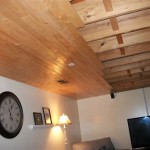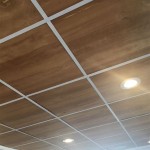What To Do With Old Ceiling Tiles In The Atlanta, Georgia Area
Renovating a home or business often involves the removal of old ceiling tiles. Disposing of these materials responsibly and in accordance with local regulations is crucial for environmental sustainability and adherence to legal requirements. In the Atlanta, Georgia area, several options exist for managing old ceiling tiles, each with its own set of considerations.
Understanding the composition of the ceiling tiles is the first step in determining the appropriate disposal or repurposing method. Many older ceiling tiles contain asbestos, a hazardous material that requires specialized handling. If asbestos is suspected, testing by a certified professional is mandatory before any further action can be taken. Disturbing asbestos-containing materials can release harmful fibers into the air, posing significant health risks. Assuming the tiles are asbestos-free, options for disposal include landfill disposal, recycling (for specific types of tiles), and donation or reuse (if the tiles are in good condition). Each of these approaches necessitates careful planning and execution to ensure environmental and regulatory compliance.
Improper disposal of ceiling tiles can lead to environmental contamination and potential legal penalties. Landfills have limited space, and construction debris, including ceiling tiles, contributes significantly to the waste stream. Recycling offers a more sustainable alternative, diverting materials from landfills and conserving natural resources. Donation or reuse can further extend the lifespan of the tiles, reducing the demand for new materials and minimizing environmental impact. The optimal course of action depends on the material composition, condition, and quantity of the tiles, as well as the available resources and local regulations.
Asbestos Testing and Abatement
The presence of asbestos in older ceiling tiles is a significant concern. Asbestos was commonly used in building materials before its health hazards were fully understood. If the building was constructed before the 1980s, the likelihood of asbestos-containing materials being present increases considerably. The only way to definitively determine if ceiling tiles contain asbestos is through laboratory testing. Certified asbestos inspectors can collect samples and send them to accredited laboratories for analysis. These professionals are trained to handle asbestos-containing materials safely and to follow strict protocols to prevent fiber release.
If asbestos is confirmed, abatement is necessary before the tiles can be removed. Asbestos abatement involves the safe removal and disposal of asbestos-containing materials by licensed professionals. These professionals use specialized equipment and techniques to minimize fiber release and to protect workers and the environment. The abatement process typically involves sealing off the work area, using negative air pressure to prevent fibers from escaping, and carefully removing the asbestos-containing materials. The removed materials are then packaged and transported to a designated disposal facility that is authorized to handle asbestos waste. It is illegal and dangerous to attempt to remove asbestos-containing materials without proper training and equipment.
In the Atlanta area, several companies specialize in asbestos testing and abatement. It is crucial to select a licensed and reputable contractor with a proven track record of safe and effective asbestos removal. Check for proper certifications, insurance, and references before hiring any contractor. The cost of asbestos testing and abatement can vary depending on the size of the area, the amount of asbestos-containing materials, and the complexity of the removal process. While the cost can be substantial, it is a necessary investment to protect human health and the environment.
Landfill Disposal of Non-Hazardous Ceiling Tiles
If testing confirms that the ceiling tiles do not contain asbestos or other hazardous materials, landfill disposal is a viable option. However, simply tossing the tiles into a regular trash bin is typically not permitted. Most municipalities have specific regulations regarding the disposal of construction and demolition debris, including ceiling tiles. Contacting the local waste management authority or a private waste disposal company is essential to determine the proper procedures for disposing of the tiles.
Some landfills may require that construction and demolition debris be separated from other types of waste. This may involve renting a separate dumpster specifically for the ceiling tiles. Other landfills may accept mixed waste but may charge higher fees for construction debris. It is important to inquire about any specific requirements or restrictions before transporting the tiles to the landfill. Some landfills may also require documentation, such as proof of asbestos testing, to verify that the materials are safe for disposal.
The cost of landfill disposal varies depending on the volume of the waste and the landfill's tipping fees. Tipping fees are the charges that landfills assess for each ton of waste that is disposed of. These fees can fluctuate depending on market conditions and the availability of landfill space. Obtaining quotes from multiple waste disposal companies can help to ensure that the best price is obtained. It is also important to factor in the cost of transporting the tiles to the landfill, which may involve renting a truck or hiring a hauling service.
Recycling and Repurposing Options
Recycling ceiling tiles is a more environmentally friendly alternative to landfill disposal. However, not all ceiling tiles are recyclable. Mineral fiber ceiling tiles, which are commonly used in commercial buildings, are often recyclable through specific programs offered by manufacturers. These programs typically involve collecting the tiles and sending them back to the manufacturer for reprocessing into new ceiling tiles. Contacting the manufacturer of the ceiling tiles is the best way to determine if a recycling program is available.
Some construction and demolition recycling centers may also accept certain types of ceiling tiles. These centers typically sort and process materials, separating recyclable items from non-recyclable waste. Check with local recycling centers to see if they accept ceiling tiles and what their requirements are. Some recycling centers may charge a fee for accepting materials, while others may offer a credit for recyclable items.
Repurposing old ceiling tiles is another way to reduce waste and give the materials a new life. Depending on their condition and appearance, ceiling tiles can be used for a variety of creative projects. For example, they can be painted and used as decorative panels, or they can be cut and used as insulation in sheds or other outbuildings. The possibilities are limited only by imagination. However, it is important to ensure that any repurposed ceiling tiles are not a fire hazard and that they are used in a safe and responsible manner.
Before repurposing ceiling tiles, it is essential to ensure that they are clean and free of any contaminants. Dust, dirt, and mold can accumulate on ceiling tiles over time, making them unsuitable for reuse. Thoroughly cleaning the tiles with a mild detergent and water can help to remove these contaminants. If the tiles show signs of mold growth, they should be discarded immediately. Mold can pose significant health risks, and attempting to clean mold-infested materials can release spores into the air.
When considering repurposing options, it is also important to consider the long-term durability of the tiles. Ceiling tiles are not designed to withstand exposure to the elements, so they should not be used in outdoor applications. They are also not particularly strong, so they should not be used in load-bearing applications. Using ceiling tiles in inappropriate applications can lead to premature failure and potential safety hazards.
In conclusion, managing old ceiling tiles in the Atlanta, Georgia area requires careful consideration of the material composition, local regulations, and environmental impacts. Asbestos testing is paramount for older buildings, and proper abatement is crucial if asbestos is present. Landfill disposal is an option for non-hazardous tiles, but recycling and repurposing offer more sustainable alternatives. By following these guidelines, homeowners and businesses can responsibly dispose of or reuse old ceiling tiles, minimizing environmental impact and ensuring compliance with local laws.

Replacing Drop Ceiling Tiles

Replacing Drop Ceiling Tiles

Replacing Drop Ceiling Tiles

Replacing Drop Ceiling Tiles

Replacing Drop Ceiling Tiles

Southside Acoustical Ceilings Home

What Do Asbestos Ceiling Tiles Look Like Removal Pro

What Do Asbestos Ceiling Tiles Look Like Removal Pro

Southside Acoustical Ceilings Home

Southside Acoustical Ceilings Home
Related Posts








